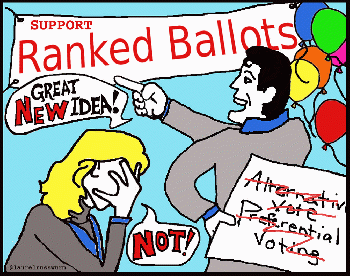Alternatives are Good To Have
Plurality voting (a.k.a. first-past-the-post voting) is, in the minds of most people, the one and only way to vote. In fairness, few people have ever given the question much thought. Nevertheless, a significant minority of people are familiar and often even support the adoption of Instant Runoff Voting(IRV) to replace plurality voting. However, even within this minority, very few have considered that there might be better alternatives thanIRV. IRV has long been in use in Australia and it has been used in a few localities and recently throughout the state of Maine.
Maine adopted IRV shortly after clearly experiencing a defect with plurality voting called the spoiler effect. The spoiler effect is understood not to be an issue when using IRV and concern about the spoiler effect seems to be the principle selling point for IRV. But in fact, many other voting systems are at least as immune to the spoiler effect as is IRV.
In recent years, the term, ranked voting (sometimes called ranked-choice voting), has come into use as an alternative name for IRV. But traditionally, the term ranked voting was understood to encompass many different voting systems with IRV being just one example. In this older terminology (which we adopt both here and other articles), a voting system is considered a ranked voting system provided that voters are asked to list, starting with their most favored candidate and with other candidates successively less supported appearing later in the list. As all voting systems must do, IRV also specifies how the winner is to be determined from the voters' ballots.
Choice of the algorithm to be used for determining the winner is certainly important, but it is not the only concern. An old saying that you can't make a silk purse out of a sow's ear. In 2022, you are more likely to hear or read an updated version, garbage-in, garbage-out but for an election (just as for a poll) the lesson is that no matter how you tally the ballots, you cannot expect a good estimate of voter opinion if the ballots in some way prevent voters from accurately expressing their preferences or if they somehow encourage voters to be less than honest. A satisfactory voting system should begin with easily interpreted questions and it should avoid doing anything that would encourage voters to give wrong answers. So let us first consider ranked voting from this perspective.
Just How Bad Could Ranked-Choice Ballot Data Be?
In my first experience with ranked voting, my ballot had nine columns of check-boxes, one column for each of the nine candidates in a primary election, and I was asked to fill in just one box in each column to indicate the ranking of the candidates. The columns were closely spaced and accidentally I put a second mark in the fourth column, invalidating my ballot. Apparently I was not alone in doing something like this; I was told that unusually many voters had to ask for replacement ballots just as I had and they were concerned about running out of ballots.
The Good, the Bad and the Ugly (1966), poster by Jean Mascii
(Image by gameraboy from flickr) Details DMCABut if my mistake had been to mark the wrong row in column that was still blank, I would probably have recovered from my mistake by swapping the placement in the order of two candidates. That would not have bothered me since I only cared about the placement of candidates on my ballot for very few of the nine candidate columns and many of the positions in my chosen order I put there largely as a matter of convenience so that I could fill out my ballot as expected.
I knew little about most of the nine candidates and I had a solid opinion to express for for three of them. Even so, between two of those three candidates I had no strong preference and I could comfortably have swapped the positions for even those two. I suspect that for ranked voting elections with many candidates this is similar to the situation of a great many voters, probably a majority.
While a voter may feel strongly about a few of the candidates, that same voter may find some of those candidates to be equally qualified. And most voters will not know much about the remaining candidates or for some other reason fail to have a firm opinion about them. Given such realities, for a voter to constrict a strict ranking will necessarily require a considerable amount imaginary coin-flipping. The structure of ranked voting makes many voters feel obligated to fill their ballots with numerous little fibs of convenience about their preferences. Much of the time, swapping the order of two candidates does not introduce a new lie but rather just the substitution of one convenient fib for another. Proponents of ranked voting systems may believe these fibs to be innocent and harmless, but at best that is just an article of faith.
There is no way, once ballots are collected, to distinguish the little fibs from truly important and heartfelt opinions; there is no alternative to treating all preferences expressed on the ballots equally valid and important. And in an election, all of those little fibs could mount up while tallying thousands or tens of thousands or perhaps even millions of ballots. For a given rank-choice election it is just hard to tell and probably no one could say for certain whether the election went as the voters intended. But many elections are important so why take that chance?
An additional consideration is that, just as with plurality voting, ranked voting methods make it necessary for voters to compare candidates with each other. Especially when two candidates seem closely matched, but even in instances where the voter has an strong preference for one of the two candidates, the voter may judge that the best strategy is to let horse-race considerations govern voting. A recent poll or a pundit's opinion of which of the two is more electable may govern the voter's decision about which to place first, leading to an even more troublesome corruption of ballot data.
For democracy's sake, ballot data should measure voters' perceptions of candidate suitability for office and certainly not be founded on gossip about who seems likely win election. Ideally, election ballots should avoid coaxing voters even to make comparisons between candidates. And it actually is possible instead just ask voters to evaluate each candidate on his or her own merit, not in comparison with other candidates. This alternative is what is sometimes called evaluative voting. There are surely as many evaluative voting systems as there are ranked voting systems, but no voting system can be both ranked and evaluative. The most widely familiar evaluative voting system is Approval Voting.
We have shown that ballot data from any ranked voting election will be deficient as a measurement of voter opinion. But specific to IRV, there is yet another problem, a problem that in another article I named this the Intuitive Voter Problem. Typically, in a ranked voting election, voters are not actually asked to rank all of the candidates in order; instead, they are told to just rank as many candidates as they want. The requirement to list every candidate is mostly for theoretical convenience, not something done real-world elections. Nonetheless it is important how ballots with missing entries are handled. In the case of IRV, skipping a candidate on a ballot results in that candidate being treated less favorably than any of the candidates who are explicitly listed on the ballot, and unfortunately, that is not at all what most voters expect to happen.
Generally, voters will be concerned about only a small number of candidates and, without considering the implications, those few candidates are the only ones that the voter takes the trouble to rank. The first few in the voter's list will be the candidates that the voter hopes will win and the last few will likely be the ones whom the voter actually dislikes and hopes will lose (and incidentally there is no way, when ballots are tallied, to locate where that change from support to opposition happens). Voters do this because it seems the normal, intuitive way to vote in a ranked-choice election.
Only a few voters will realize that, given the way IRV ballots will be tallied, their opinions would be more accurately reflected if instead they list all of the don't-know/don't-care candidates at the end of their list and let the candidates whom the voter actually opposes be the ones to skip over. Unfortunately, even this improved method gives an advantage to some of the don't-care candidates over others and this could give an advantage to candidates with names alphabetically lower or displayed earlier on the ballot.
The fundamental problem is that IRV interprets the ballot in a manner that is at odds with natural voter expectations. Voter education might relive the damage some, but it seems unlikely that education could entirely eliminate this kind of flaw in election data. Better would be to turn to a voting system where ballots are counted in a manner that conforms with likely voter expectations. This would be prerequisite for a voting system to gather voter opinions accurately.
While it might be considered overly harsh to claim that the information collected in a ranked choice election is mere garbage, surely that data is sufficiently dubious to be quite concerning. Still, even with perfectly accurate and valid data, election outcomes also depend on the way the data is evaluated. So how does IRV do on that score?
Some Ugly Truths
One might easily imagine IRV to have been motivated by the inadequacy of plurality voting, once the spoiler effect became recognized. Plurality is a system that (due to the spoiler effect) can fail to select the rightful winner whenever there are more than two candidates. Looking for a better alternative than crudely limiting elections to just two candidates, it would be natural to consider that individual sports like singles tennis solve a similar dilemma for tournaments. Tennis tournaments are conducted through a series of games, necessarily between just two contestants.
Perhaps such that analogy is what suggested the idea for IRV to simulate a series of plurality contests, removing one candidate at a time while avoiding a costly resort to many actual elections, Given the ranked list from each voter, the first round of ballot counting (simulating the first single-elimination election) proceeds using only the first entry in each voter's list. Subsequent rounds of coun
ting use the first entry in each list who has not yet been eliminated.
The surprisingly obvious flaw in this strategy (as it is implemented by IRV) is that, until the very last round of counting, each of these simulated plurality elections involve more than two candidates. While IRV does avoid the spoiler effect, with only a single exception, each of the simulated runoff elections could potentially be spoiled. Moreover, the IRV evaluation process suffers from enough complexity that such errors will likely be very well disguised. With IRV the worry of a single catastrophic error is avoided but in exchange ther
e is the opportunity for the cumulative effects of many separate preliminary errors. Nevertheless, even this flawed IRV approach might overall be an improvement over plurality voting, but it seems entirely possible that is merely wishful thinking.
The single elimination tactic wold seem to work better if each elimina
tion round involved only two candidates. If the analogy with a tennis tournament were followed more closely, the ballot-counting would proceed by choosing two of the candidates (at random, perhaps) and use the ballots to determine which of those two is preferred by the most voters. The less widely preferred candidate would be eliminated and two more candidates would be chosen from the remaining candidates to determine the next candidate to be removed. Perhaps someone has previously described this voting system and give it a name and someone will provide a reference to me. Meanwhile when we need to refer to it let us call this system Tennis Tournament Voting (TTV).
A difficulty with TTV is that, for practicality's sake, voters may be allowed
to skip over candidates. In that case it is quite possible for pairs to be selected only to discover that no ballots actually list both of the two candidates. Should that happen, there would be no basis for choosing which of the pair to eliminate. Perhaps some clever strategy might be found for dealing with such cases. Or perhaps the only solution would be to insist that voters not skip over any candidates.
A different, but similar concern with IRV is to note that IRV eliminates, in each iteration, the candidate who is most favored by the least number of voters. But clearly a more sensible approach would be to instead remove the candidate who is (among the remaining candidates) the least favored by the most voters. That ranked voting system is explored again in a recent article.
While all of the ranked voting systems we have discussed use an iterated approach for evaluating ballots, that is not a necessary feature of ranked voting. In particular, the Borda voting system requires only be a single reading of the ballots to select the winner and there are actually an infinite number of variations on Borda voting, all of them ranked voting systems and none of them involve iterated counting of ballots. Perhaps Borda voting would serve better than IRV; that is possible and it is simpler than IRV.
There is no shortage of voting systems even among just the ranked voting systems and we might be tempted to search among them for the best; surely some would be found to be better choices than others. But in addition to considerations of questionable data quality, there is a theoretical result called Arrow's Theorem which shows that, no matter how the tally is conducted, no ranked voting system will actually prove satisfactory in a clearly defined and reasonable sense. And that theorem assumes the ballot data is without flaws.
Advocates of ranked voting sometimes argue that every voting systems is faulty. Possibly they are thinking of Gibbard's theorem, but that theorem strengthens the notion of satisfactory to include the prevention of strategic voting. Preventing strategic voting, however desirable that might seem, is a quite high bar; can there be a way to avoid both human ingenuity and hubris that might bring people to try out some plan? It seems likely that no voting system is perfect, but that surely is no justification for settling IRV or any other voting system when a better choice can be found.
The appeal to Arrow's theorem may seem convincing mostly to mathematicians, but a clear example of what could go wrong using IRV is available as an example. A quite similar example shows how an apparently improved ranked voting system can also fail. No doubt such examples could be constructed for Borda voting, for TTV and other ranked voting systems as well.
But There Are Yet Better Alternatives
Especially in light of Arrow's theorem, it would be foolish to restrict consideration to only ranked voting systems and the previous article we argued that Balanced Approval Voting (BAV) would be a particularly attractive choice. BAV is an evaluative system and that alone gives it an edge over any ranked voting system. With BAV, the voter is asked to consider each candidate by marking a box to indicate either support or opposition to that candidate; for that matter the voter is free to mark neither box if the voter chooses. These are easy questions for the voter to answer and with BAV it is hard to imagine why a voter might lie, though without much doubt some will seek out strategies to game even this system. Data from an election seems credible so long as voting and handling of ballots is secure. That's a good start, but in addition the method of tallying the ballots is straightforward and entirely faithful to the voters' intent. As a bonus, BAV is apt to make impossible the preservation of a two-party polarized politics.
Still, human ingenuity can present surprises so it would seem impossible to argue that BAV is the best possible alternative. Still, at this time (just as in 2014), I cannot offer an alternative that seems better.







